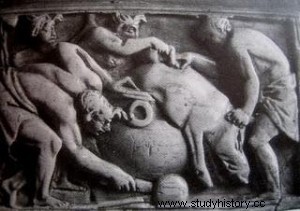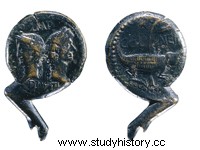What began at the end of the third century a. C. as a strategic invasion to cut the Carthaginian supply lines that supported the invasion of Rome by Hannibal during the Second Punic War, it soon became a conquest that in about twelve years had completely expelled the Carthaginian forces from the Peninsula. However, it would still take two centuries for Rome to dominate the entire Iberian Peninsula, mainly due to the strong resistance that the Celtiberians, Lusitanians, Asturians, Cantabrians... offered to the Romans. Our Hispania must have had something that was worth fighting for two centuries... the garum, the oil, the puellae gaditanae (girls dancers and singers from Gades who achieved great fame at that time, fame that reached Rome)... and the Serrano ham .
The Romans were already consumers of ham, the so-called prosciutto . Cato the Censor (234-149 BC) wrote the first document on the conservation of pork hams:they were salted for a few days, then smeared with olive oil and hung to dry. He mentions that pernae (ham) and petasones (forelegs) were produced in the Emilian plain – the one from Parma was and is famous – as provisions for the army as well as for banquets in Rome. We also know that after his victory over the Romans at Trebbia In 217 BC, Hannibal entered Parma and confiscated the hams stored in wooden barrels from the inhabitants as war booty. A century later in his De re rustica the historian Varrón (116-27 BC) and the geographer Strabo (63 BC-24 AD), confirm the fame of Parma prosciutto.

Before the arrival of the Romans, the pre-Roman peoples already delighted in the delicacies generously given to them by the pigs:cured meats, sausages... and, above all, hams - in ancient Tarraco a ham fossil was found with more 2,000 years old -. If the Romans already knew ham, why did they want ours... because of its quality and more intense flavor .
Strabo in his Geographica He mentions the great quality of the Cantabrian and Cerreta hams, since the pigs were fed on acorns, and he compares them with the Pyrenean Ceretanos, whose haunches were highly coveted after the Pax Romana.
Martial in an epigram:
From the country of the cerretanos or the manapianos (Celtic people of the Rhine area) bring me a ham, and the sweet tooth that fills themselves with steaks.
But Hispanic ham could not be afforded by just anyone, it became a luxury item. In fact, in the Edict of Maximum Prices or Edict of Diocletian from 301 a price of 20 denarii was fixed for a pound (326 grams) of cerritano ham. To get an idea of its price, 20 denarii was the daily salary of a muleteer or a peasant. Such fame came to acquire that themed coins were even minted …

